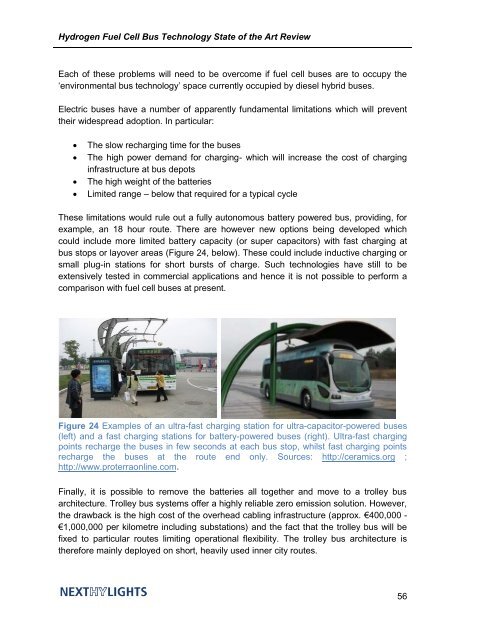Hydrogen Fuel Cell Bus Technology State of the ... - NEXTHYLIGHTS
Hydrogen Fuel Cell Bus Technology State of the ... - NEXTHYLIGHTS
Hydrogen Fuel Cell Bus Technology State of the ... - NEXTHYLIGHTS
Create successful ePaper yourself
Turn your PDF publications into a flip-book with our unique Google optimized e-Paper software.
<strong>Hydrogen</strong> <strong>Fuel</strong> <strong>Cell</strong> <strong>Bus</strong> <strong>Technology</strong> <strong>State</strong> <strong>of</strong> <strong>the</strong> Art Review<br />
Each <strong>of</strong> <strong>the</strong>se problems will need to be overcome if fuel cell buses are to occupy <strong>the</strong><br />
„environmental bus technology‟ space currently occupied by diesel hybrid buses.<br />
Electric buses have a number <strong>of</strong> apparently fundamental limitations which will prevent<br />
<strong>the</strong>ir widespread adoption. In particular:<br />
The slow recharging time for <strong>the</strong> buses<br />
The high power demand for charging- which will increase <strong>the</strong> cost <strong>of</strong> charging<br />
infrastructure at bus depots<br />
The high weight <strong>of</strong> <strong>the</strong> batteries<br />
Limited range – below that required for a typical cycle<br />
These limitations would rule out a fully autonomous battery powered bus, providing, for<br />
example, an 18 hour route. There are however new options being developed which<br />
could include more limited battery capacity (or super capacitors) with fast charging at<br />
bus stops or layover areas (Figure 24, below). These could include inductive charging or<br />
small plug-in stations for short bursts <strong>of</strong> charge. Such technologies have still to be<br />
extensively tested in commercial applications and hence it is not possible to perform a<br />
comparison with fuel cell buses at present.<br />
Figure 24 Examples <strong>of</strong> an ultra-fast charging station for ultra-capacitor-powered buses<br />
(left) and a fast charging stations for battery-powered buses (right). Ultra-fast charging<br />
points recharge <strong>the</strong> buses in few seconds at each bus stop, whilst fast charging points<br />
recharge <strong>the</strong> buses at <strong>the</strong> route end only. Sources: http://ceramics.org ;<br />
http://www.proterraonline.com.<br />
Finally, it is possible to remove <strong>the</strong> batteries all toge<strong>the</strong>r and move to a trolley bus<br />
architecture. Trolley bus systems <strong>of</strong>fer a highly reliable zero emission solution. However,<br />
<strong>the</strong> drawback is <strong>the</strong> high cost <strong>of</strong> <strong>the</strong> overhead cabling infrastructure (approx. €400,000 -<br />
€1,000,000 per kilometre including substations) and <strong>the</strong> fact that <strong>the</strong> trolley bus will be<br />
fixed to particular routes limiting operational flexibility. The trolley bus architecture is<br />
<strong>the</strong>refore mainly deployed on short, heavily used inner city routes.<br />
56


